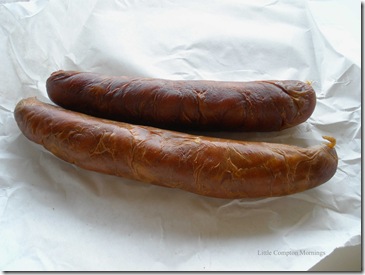 In Rhode Island, where the Portuguese are second only to the Italians for largest immigrant population, Portuguese food (like Italian food), is truly part of traditional Rhode Island cuisine. In addition to loving our Portuguese pao de milho and sweet bread, we eat Portuguese chouriço alongside eggs as readily as bacon or ham. Outsiders sometimes think our chouriço is like Spanish chorizo, or even Mexican, but it is not. As you know by now, I adore Mexican chorizo, but it is a different animal. Actually, it’s the same animal, the pig, but a different item altogether, despite surface similarities. All three are distinct in taste, with the Mexican being more finely ground and vinegary, as well as seasoned with chili pepper, and the Spanish containing more paprika and smoked to a harder, drier, finish.
In Rhode Island, where the Portuguese are second only to the Italians for largest immigrant population, Portuguese food (like Italian food), is truly part of traditional Rhode Island cuisine. In addition to loving our Portuguese pao de milho and sweet bread, we eat Portuguese chouriço alongside eggs as readily as bacon or ham. Outsiders sometimes think our chouriço is like Spanish chorizo, or even Mexican, but it is not. As you know by now, I adore Mexican chorizo, but it is a different animal. Actually, it’s the same animal, the pig, but a different item altogether, despite surface similarities. All three are distinct in taste, with the Mexican being more finely ground and vinegary, as well as seasoned with chili pepper, and the Spanish containing more paprika and smoked to a harder, drier, finish.
Portuguese chouriço is a lightly smoked sausage made with coarsely ground pork shoulder, garlic, paprika, vinegar, pepper, salt, and sometimes red wine, and stuffed into natural casings. Most come in mild, which is standard, or hot versions. “Gourmet” versions, including lower-fat and chicken sausages, are now available (and they are very good), as are finely ground and skinless sausages, and ground meat and patties. Several area sources with different offerings are Sardinha’s, which is carried primarily at upscale stores and which you may need to order online, and Amaral’s, Gaspar’s, Furtado’s, and Michael’s, which are widely available in stores locally as well as online. If you live in Rhode Island or the part of Southeastern Massachusetts that injects itself between Rhode Island towns, you can make a pilgrimage to Chaves Market on Columbia Street in Fall River for the store’s own chouriço—mild, hot, or extra fat, and so good that they don’t bother to carry any
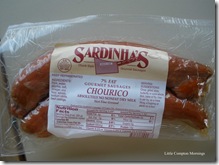 packaged brand. Chave’s chouriço is a true artisan product, and well worth the trip. In case you’re wondering, the extra-fat chouriço is preferred by some Portuguese cooks for the richness it gives to soups and stews.
packaged brand. Chave’s chouriço is a true artisan product, and well worth the trip. In case you’re wondering, the extra-fat chouriço is preferred by some Portuguese cooks for the richness it gives to soups and stews.Chouriço is a common ingredient in Portuguese dishes, from feijoado to kale and clam soup, clam and chorizo stew, chorizo with beans (especially favas), and egg preparations of all kinds. Sometimes it is just set on fire to cook (“flamed”) and sent to the table. Here is a recipe for a familiar Rhode Island classic.
LCM Portuguese Chouriço and Pepper Sandwich
The Portuguese dish Chouriço and Peppers is commonly a stewed dish of crumbled choriço with red wine and tomatoes served over rice, and used also as a sandwich filling. In college, my Portuguese suite-mates referred to it as “shittiesandpeppers,” its popular moniker. It is a favorite of all Rhode Islanders. My version is closer to a sauté of sliced rather than crumbled sausage, without sauce, and I serve it on a Portuguese sweet bread roll, which I have come to love for hamburgers and deli sandwiches as well. You could serve yours more traditionally with tomato sauce and on a soft torpedo-shaped plain roll, if you wish. And you can also prepare the entire thing on the charcoal grill, omitting the wine. Makes 3 good-sized sandwiches.
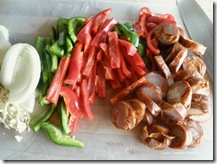
½ lb, generous, hot, mild, or mixed chouriço
1 small red pepper
1 small green pepper
½ medium onion
1 fat clove garlic
Salt, pepper
1 tea-1 T olive oil (see NOTE)
Big splash (about 2 T) red wine
Portuguese sweet bread rolls
Slice the garlic into thin slivers. Cut the peppers in half horizontally and slice them vertically into ¼” slices. Slice the onion into ¼” slices, and slice the chouriço into ¼” rounds, leaving the skin on. (You can also remove the skin after cooking sausages whole; see below).
Put about a teaspoon of olive oil into a large heavy skillet and heat it to medium-high, rotating the pan so that the oil coats the surface. When the pan begins to smoke, turn the heat down a little and toss in the choriço; cook, stirring with a wooden spoon, until the fat renders; do not over-brown. Remove from the pan and set aside. (If you want your chouriço skinless, cook it whole before cutting; remove it from the pan and pierce the skin with a sharp knife; draw the knife down lengthwise; remove the skin; and slice into ¼” rounds).
Restore the heat to medium-high and toss in the peppers. Cook for about a minute, stirring, then toss in the onions; cook another minute, then toss in the garlic, salt, and pepper to taste. Cook another minute, return the chouriço to the pan, splash with the wine, toss around, and cover loosely, letting steam escape, to let the vegetables soften a bit—about 5 minutes cooking time total from when you throw in the peppers. (NOTE: If you are using a commercial brand like Michael’s or Gaspar’s, the sausages will yield enough fat and you will need only a little oil; if an artisanal or lower-fat brand, you will need to add more oil to cook the peppers.)
Toast Portuguese sweet bread rolls lightly, pile with the chouriço and peppers, and enjoy a taste of Rhode Island.
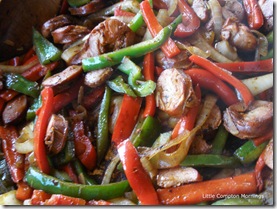
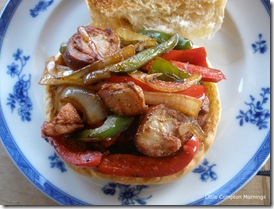
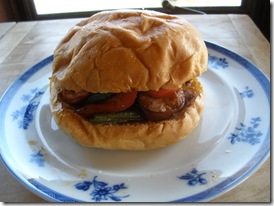
___
Notice: Voting for Rhode Island Monthly’s Best of Rhode Island is open, and there is a category for best local website. If you appreciate Little Compton Mornings and would like to show your support, you may vote here now: http://www.rimonthly.com/Rhode-Island-Monthly/Best-of-Rhode-Island/Best-of-Rhode-Island-Ballot/ . I thank you!

3 comments:
I love your blog! You are so right about our New England traditions of eating local, seasonal food. (I fondly remember sweet corn and tomato summer suppers in NH from when I was a kid.) I look forward to reading more about what's good to eat in Rhode Island!
Jane, I just read this by you,
"The culinary degree is good for learning chemistry (syneresis, anyone?) and food safety, and maybe for trusting me when I tell you not to refrigerate something"
Can you tell us what you are referring to when you write that and also perhaps you could also clear something up for me about freezing and refreezing meat.
I brought fresh chopmeat home, froze it and later in the week defrozed it and made meatballs.
Now I understand that once it's cooked it is okay to refreeze because it cooked not raw; but is it harmful to refreeze meat twice if it is cooked. I've asked my butcher and he can't give me a conclusive answer.
Thanks for your time,
Sandy K.
Sandy: What I mean is that sometimes thing that we automatically refrigerate or grew up thinking had to go right in the refrigerator do not, and may actually be better for being left out before serving (even if we refrigerate later).
You can refreeze cooked meat twice (like leftover meatballs that were not eaten the first time out of the freezer, provided it has been kept in the refrigerator or a safe temperature, but you will lose quality each time. Better just to leave it in the refrigerator and finish it up over the next day or so. Use small containers or zip lock bags to portion food so you don't have this issue as much.
Post a Comment